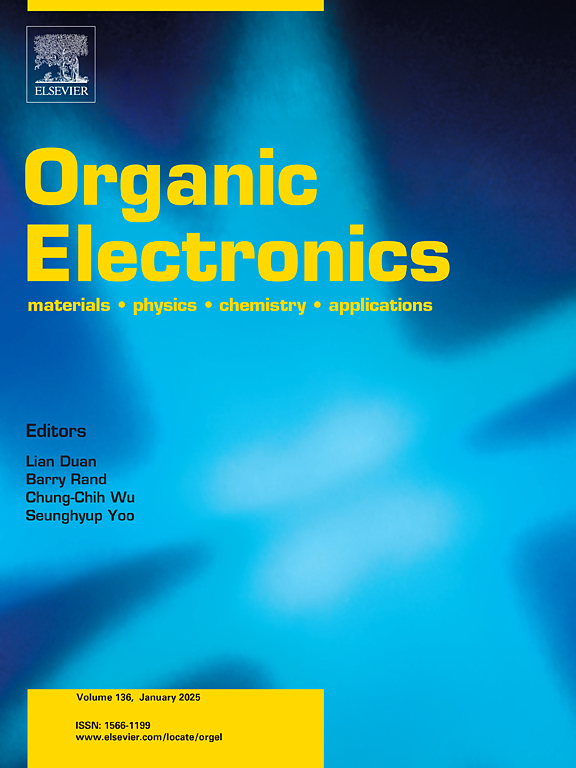基于苯并噻唑的具有局部杂化和电荷转移激发态(HLCT)特征的绿至深红色发光oled供体-受体-受体(D-A-A ')型荧光发射器的设计
IF 2.6
4区 工程技术
Q3 MATERIALS SCIENCE, MULTIDISCIPLINARY
引用次数: 0
摘要
有机发光二极管(oled)在固态照明和平板显示中有着重要的应用。为满足高性能有机发光器件的要求,新型有机发光器件的开发备受关注。吸电子基团苯并噻二唑(BTZ)由于其刚性的平面结构有利于其发射性能而被广泛应用于有机发射体中。目前,基于BTZ骨架的有机发射体的化学结构大多以对称的D-A-D构型为主。在此,我们设计并合成了一系列具有局部和电荷转移(HLCT)激发态特征的非对称供体-受体-受体(D-A-A)型荧光发射器。由于其π共轭扩展,D-A-A '型分子结构有利于增强分子内电荷转移,实现发射体红移。值得注意的是,通过改变这些荧光发射器在主体材料中的掺杂浓度,OLED器件的发射可以从绿色到深红色进行精细调节,从而实现广泛的光色光谱。此外,值得强调的是,引入三苯胺基团可以使器件在更高的掺杂水平下获得更高的EQEs。与掺杂浓度为10% wt%的7b相比,掺杂浓度为50% wt%和100% wt%时,7b器件的最大EQEs分别提高到4.8%和3.5%。特别是,基于7b的非掺杂OLED具有优异的红色纯度,其CIE坐标为(0.63,0.36),非常接近Rec. 709标准红色CIE坐标(0.64,0.33)。本文章由计算机程序翻译,如有差异,请以英文原文为准。

Design of donor-acceptor-acceptor (D-A-A′)-type fluorescence emitters based on benzothiadiazole with the hybridized local and charge-transfer (HLCT) excited state feature for green to deep-red emitting OLEDs
Organic light-emitting diodes (OLEDs) have significant applications in solid-state lightings and flat-panel displays. The development of novel organic emitters to meet the demands of high-performance OLEDs is attracting much attention. The electron withdrawing group benzothiadiazole (BTZ) is widely used in organic emitters due to its rigid planar structure which will benefit the emission performance. At present, the chemical structures of organic emitters based on BTZ skeleton are mostly dominated by the symmetric D-A-D configuration. Herein, we designed and synthesized a serial of asymmetric donor-acceptor-acceptor (D-A-A′)-type fluorescence emitters with the hybridized local and charge-transfer (HLCT) excited state feature. Due to its extended π-conjugation, the D-A-A′ type molecular architecture is conducive to enhancing intramolecular charge transfer and achieving redshift of emitter. Notably, the emission of OLED devices can be finely tuned from green to deep red by varying the doping concentrations of these fluorescent emitters within the host material, thereby enabling a broad spectrum of light colors. Moreover, it is worth highlighting that the introduction of triphenylamine groups can enable devices at much higher doping levels to achieve higher EQEs. Compared with the maximum EQE of 3.1 % for the10 wt% doped OLED based on 7b, the maximum EQEs of devices based on 7b at the doping concentration of 50 wt% and 100 wt% increase to 4.8 % and 3.5 %, respectively. Especially, the non-doped OLED based on 7b exhibits excellent red color purity with the CIE coordinate of (0.63, 0.36), which is very close to the Rec. 709 standard red color CIE coordinate (0.64, 0.33).
求助全文
通过发布文献求助,成功后即可免费获取论文全文。
去求助
来源期刊

Organic Electronics
工程技术-材料科学:综合
CiteScore
6.60
自引率
6.20%
发文量
238
审稿时长
44 days
期刊介绍:
Organic Electronics is a journal whose primary interdisciplinary focus is on materials and phenomena related to organic devices such as light emitting diodes, thin film transistors, photovoltaic cells, sensors, memories, etc.
Papers suitable for publication in this journal cover such topics as photoconductive and electronic properties of organic materials, thin film structures and characterization in the context of organic devices, charge and exciton transport, organic electronic and optoelectronic devices.
 求助内容:
求助内容: 应助结果提醒方式:
应助结果提醒方式:


